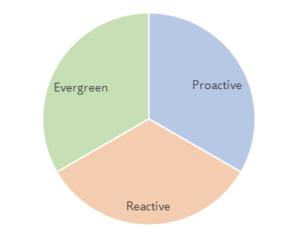The Pillars of Content Creation
Once the broad strokes of an overarching content plan have been established, sketching out the finer details of content presents its own practical challenges – many of which are not addressed by generic online content guides. This article will attempt to chart those areas of unexplored ground, offering advice on content creation that others haven't told you. Or, at least, haven't told you enough about.
Tone
Tone is the way one person ‘speaks’ to another, or in this case how a company shares a message with its audience. Words and phrases often carry different meaning to different people. In person, how loudly, quickly or sharply something is spoken has a considerable impact on how it lands. Getting it right in writing is a whole other ballgame.
An effective tone speaks to the reader on their own level. For example, simplicity and brevity are your friends if content is targeting a retail audience that may lack specialised financial knowledge. In contrast, a largely institutional audience may feel patronised by this approach.
Given the nuance, it is important to have a robust editorial process in place. This will ensure that your content does not leave the reader feeling belittled or baffled. Tone is an important element of your brand and values. If your message to market is that you are friendly, knowledgeable and value your customers – your content should make them feel engaged, educated and confident that their trust in you has not been misplaced.
Language
Language overlaps with, but is not synonymous with, tone. In this context, 'language' describes the terminology used in an article or other piece of content.
For example, is the reader likely to know what 'investment grade' or even ‘IG’ means? Someone comfortable with this language / acronym may view their inclusion in your content as confirmation that they are indeed the intended audience. It also simply saves time and real estate on the page.
In contrast, someone unfamiliar with those terms is likely to be put off and choose not to read your content. Little seems to alienate an audience more than needless jargon. It's therefore wise to err on the side of caution when gauging the general level of your audience's knowledge. A good rule of thumb is that jargon should speed up the process of consuming content, rather than slowing it down; if readers are left Googling terms, something is wrong.
Content type
It can be helpful to divide content into three broad categories:

- Evergreen – content that will remain relevant throughout market cycles.
- Reactive – content that responds to topical trends and events.
- Proactive – forward-looking content that speaks to the messages you want to put into the market
The weighting of these content types should reflect your brand and company’s priorities. For example, a business attempting to position itself on the cutting edge technologically might focus on proactive content. However, businesses generally arrive at some blend of the three, mixing the immediate relevance of reactive content with the multi-purpose nature of evergreen articles.
It's key to work smart as well as hard in this regard; if an existing piece of evergreen content applies to current market dynamics, repurpose it rather than spend resources on wholly new work.
Value-add
Why should anyone read your content? It's a simple question, but one that often doesn't receive enough consideration. In terms of content strategy, businesses tend to function more like cruise liners than speedboats, taking time to adjust course. However, churning out content for the sake of it risks not merely wasting resources but weakening brand.
Content should add clear value through presenting timely or original insights, ideally both. As readers seek information in the aftermath of a significant event, simply writing about it before your competitors can drive traffic. However, once this immediate gold rush has subsided, refreshing or unorthodox insights can breathe fresh life into well-trodden topics.
| Prompt differentiated content | Delayed differentiated content |
| Prompt generic content | Delayed generic content |
Once more, brand is a key consideration here. Would your organisation rather be known for its dynamism and responsiveness to topical events – even if this swiftness may result in less detailed content – or for presenting more refined, considered perspectives after the fact, but competing with your peers for attention?
Purposeful content should also incorporate actionable 'next steps' for readers, such as subscribing to newsletters. However, delicacy is key. A reader is more likely to embark on one of these next steps if they feel it presents tangible value to them, rather than because they're being browbeaten by incessant calls to action. Sometimes it's wiser to focus on producing targeted, effective content and allow that to do the talking.
Content creation is not a one-size-fits-all practice, with each business, audience, region and content type presenting their own nuance. However, these pillars offer a general framework to consult when producing content, which can be adapted to reflect your content strategy.